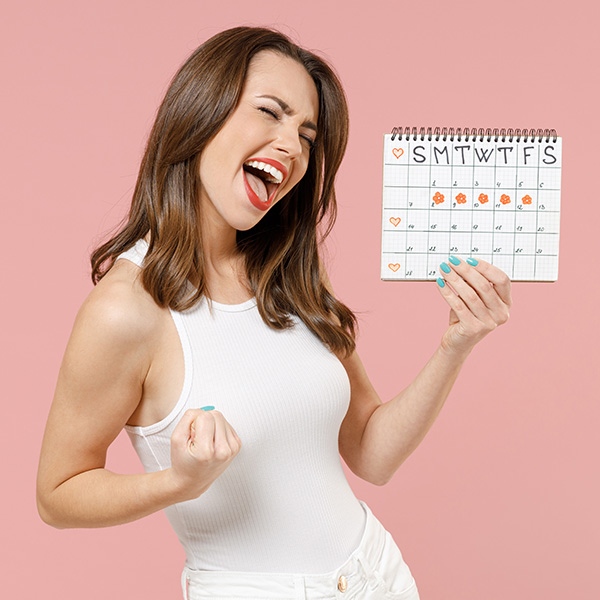Hey, fierce ladies! Ready to unleash the unspoken? We’re about to tackle a topic that’s been hush-hush for way too long: menstruation! It’s time to smash those taboos, unveil the mysteries, and bring periods into the spotlight. In this blog post, we will take you on a mind-blowing journey through the wondrous world of the menstrual cycle.
Periods can be a challenging time of the month when cramps, bleeding, low energy, mood swings, and cravings take the stage. By delving into the magical mysteries of your body and understanding why it turns your world upside down, you’ll be armed with the knowledge to conquer those pesky symptoms like a champ.
The menstrual cycle is a fascinating and intricate process that takes place in the female reproductive system every month. We’ve got hormones like FSH, LH, estrogen, and progesterone throwing a hormone party and causing all sorts of changes. Now, here’s the deal. While we often talk about a 28-day cycle, the truth is that nature likes to mix things up a bit. Anything from 21 to 40 days can still be considered totally normal and regular. So, don’t stress, embrace the uniqueness and let your body do its thing.
Your cycle is usually split into 2 phases – First up, we have the follicular phase (days 1-13), which is like the warm-up before the main event. It’s all about prepping for ovulation when an egg might make its grand entrance into the world. Then, get ready for the second phase the luteal phase (day 15-28), the post-ovulation. During this phase, our bodies are in full-on baby-making mode, gearing up for potential fertilization and implantation of that precious egg.
So what’s happening at each stage…
Day 1-5: Menstruation
This is where the journey starts! During these days, the lining of the womb says, “Adios!” and breaks down, leading to some bleeding. Now, we won’t sugarcoat it—period cramps can be a pain. But don’t worry, it’s all part of the process. On average, a “normal” period flow is around 80ml, but hey, everyone’s flow is unique. Some may have lighter periods, while others may rock a heavier flow, and that’s totally normal for them.
Now, let’s address the elephant in the room—period stigma. Periods are as natural as a sunny day, so no need to feel embarrassed. Period blood is not “dirty” or something to be ashamed of. Some folks feel the need to go overboard with cleaning during this time, but guess what? You only need to cleanse your intimate area with a pH-balanced wash like femfresh once a day (even during your period) to keep your vulval microbiome happy. For those on-the-go moments, Femfresh wipes are a fantastic option to keep you feeling fresh throughout the day.
Days 1-13: Follicular Phase
Now, onto the follicular phase! It kicks off on day one of your period. During this phase, the pituitary gland in your brain goes, “Hey, let’s release some FSH!” (Follicular Stimulating Hormone). This hormone gets those eggs in your ovaries excited and ready to mature into follicles. Talk about a growth spurt! As these follicles develop, they release estrogen, which helps prepare the lining of your uterus in case an egg decides to get fertilized. Oh, and guess what? Estrogen also gives you an energy boost and increases your pain threshold leading up to ovulation. Thanks, estrogen!
Day 14: Ovulation It’s ovulation time!
The star of the show is a mature egg that bursts out of its follicle and makes its way to the uterus. This grand exit happens thanks to a rise in LH (Luteinising Hormone). Now, some women may experience a little discomfort during ovulation, but no worries—it’s totally normal. You might also notice a change in your usual vaginal discharge, as it becomes thicker and whiter, thanks to some extra cervical mucus. Progesterone levels are higher at this time, so your skin may feel a tad oily, and guess what else? During Ovulation, nature wants to increase your chances of getting pregnant. Makes sense, right?
Days 15-28: Luteal Phase
After the egg makes its grand exit, the follicle it came from transforms into the corpus luteum. This nifty little guy produces progesterone, which helps maintain the lining of your uterus, just in case an egg decides to plant itself there. As progesterone levels rise, you may experience some PMS (pre-menstrual syndrome) symptoms. Hello, mood swings, emotional rollercoaster, increased appetite, bloating, headaches, tiredness, breast tenderness, and hey, even spotty skin or greasy hair. Plus, your libido may take a dip during this time. Estrogen levels drop after ovulation and stay low until your next period, which can leave you feeling a bit low
We encourage embracing the uniqueness of each person’s cycle and debunk any misconceptions or stigma surrounding periods. Remember, your body is amazing, and going with the flow (literally!) is the way to embrace the natural roller coaster of the menstrual cycle.



